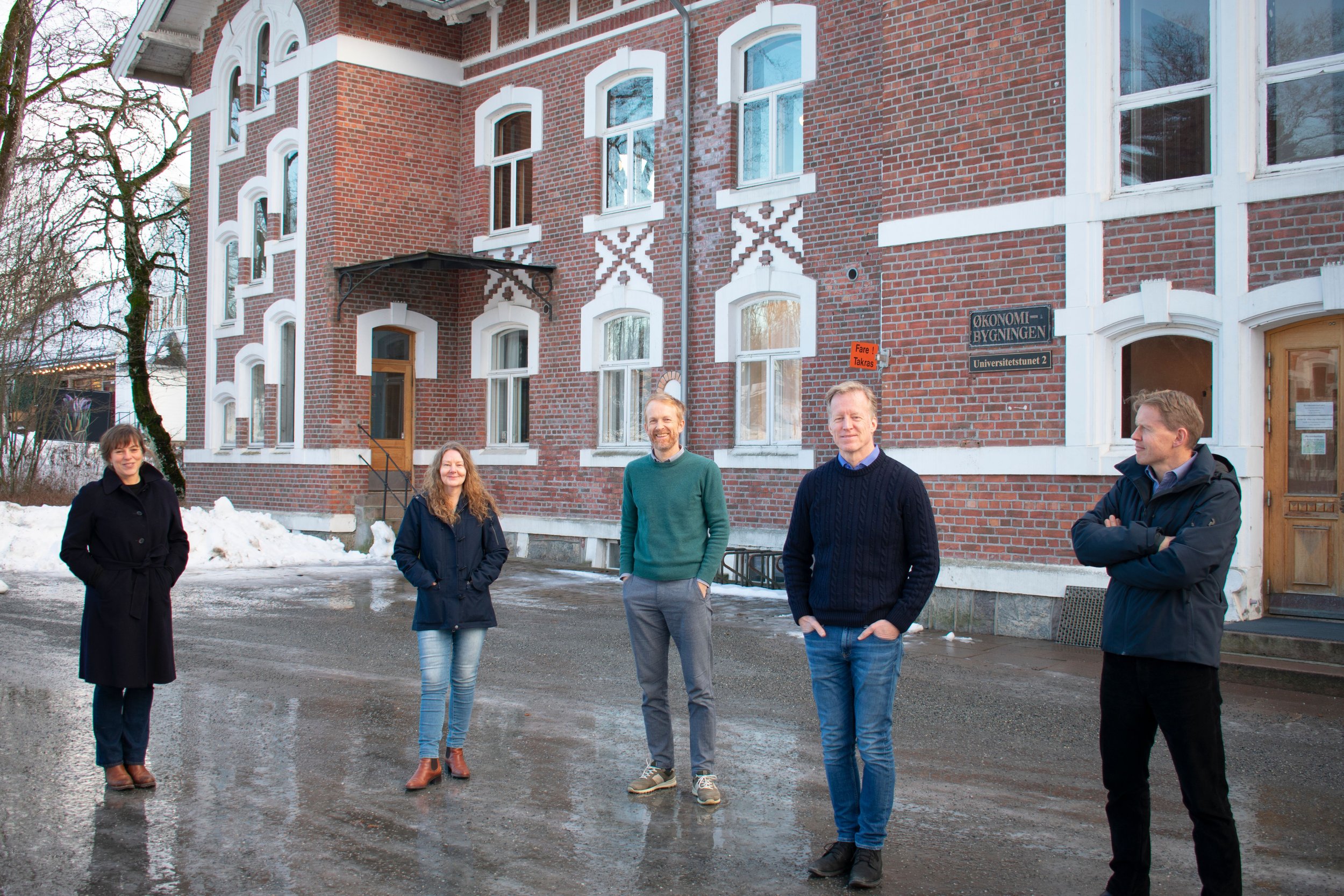New Pro-Rectors and a Vice Rector for Sustainability at NMBU

New Pro-Rectors and a Vice Rector for Sustainability at NMBU:
“We Have to Support the Students’ Enthusiasm”
This winter, the administration at NMBU announced that the university has hired two new pro-rectors. Finn-Arne Weltzien is the new pro-rector for science and innovation, together with Elise Norberg, the new pro-rector for education. The administration is also joined by Astrid Sinnes, the vice-rector for sustainability – a brand new position at NMBU. Tuntreet had a talk with all of them.
Journalist: Ingvild Lauvstad
Translator: Aleksander Mæland Munkejord
Photographer: Borghild S. Oterholdt
Photo: Håkon Sparre, NMBU
Finn-Arne Weltzein- pro-rector for research and innovation
Pro-rector for research and innovation. Professor physiology at the Veterinary Institute (since 2009). Institute leader and FU-leader at the Veterinary Institute (2019-2022). Researcher on puberty in fish
Best Christmas present: Surprise box from son, 2,5 years old
Photo: Private
Astrid Sinnes- Vice-rector for sustainability
Professor- Science didactics (since 2004). Researcher with focus on sustainability in education.
Best Christmas present: A sign from her daughter with the writing “Boss”
Photo: Håkon Sparre, NMBU
Elise Norberg- prorektor for utdanning
Senior Researcher- livestock breeding and genetics at Aarhus University (2008-2017), Institute leader and prodean at BIOVIT (2017-2021)
Best Christmas present: Gift card for education and books for refugee children
Motivated for the Work Ahead.
Finn-Arne Weltzien is motivated for the work on which he is getting started: “I have always had a passion for science”, he says. “Back in 8th grade of lower secondary school, when I was asked what I wanted to be when I grew up, the answer was always scientist, even though I had no idea what a scientist did”. Both Astrid Sinnes and Elise Norberg mention that they look forward to applying their knowledge and experience, and to get to work on an administrative level for the entire university. “I have worked a lot with education in my former position as vice-dean for education at BIOVIT, and I think we have accomplished great things. When I was faced with the opportunity of working with education for all of NMBU, it felt like just the right thing for me!” Norberg says, evidently eager.
But What Exactly is a Pro-Rector?
Weltzien avoids getting too technical, when explaining what a pro-rector is: “The rector has lots of representational tasks, both internally and externally, and is not able to simultaneously administrate all the details of each area of responsibility – that is why we have the pro-rectors. The Rectorate consists of the rector, the pro-rector for science & innovation, the pro-rector for education, the vice-rector and the head of administration. There are separate administrations for each pro-rector, and Weltzien leads the department for science, innovation and external collaboration, abbreviated ‘FIE’. “I am responsible for a number of sub-units, such as the university library and ‘ARD’ – NMBU’s innovation company”, he explains. “Overall, I work with facilitating the best possible working conditions for our scientists and innovators, and with research-political work for NMBU externally”, he summarizes.
«A pro-rector will also represent the institution externally regarding their respective areas of responsibility, together with the rector, who represents all of NMBU”, Norberg adds. “As pro-rector for education, I will be working on ensuring the quality of the education, good working environments for the students, and collaboration between the faculties. I am also the leader of the committee of academical affairs”, she explains. Weltzien finds a pro-rector important: “because it increases our capacity for ensuring professional administration of the different aspects of the university’s operation”. “There are lots of students, employees, study programs and subjects that make up NMBU, and it is vital that we have a person that is dedicated to monitoring the quality of the education”, Norberg adds.
The Vice-Rector for Sustainability – A Brand New Position at NMBU
Sinnes explains that the pro-rector is an established position, but there has never been a vice-rector at NMBU until now. “The position is an opportunity that the rector has, to create a position for something he, or she, wants to give more attention”, she explains. Sinnes points out that she is not alone responsible for the sustainability at the university: “In the end, the rector has the overall responsibility, but I will be pushing forwards in the work on integrating sustainability in all areas of the university”, she notes.
«The institutions have to be up to date, as they are responsible for educating the candidates that will work on sustainability in the future, and provide them with sufficient action competence”, Sinnes thinks. “It is important to map out the relevant content of sustainability at NMBU. There are several different views on sustainability at the university, and we have to be conscious about just that”. “Everyone at NMBU should be able to recognize their part in the mission of sustainability”, Norberg adds. She thinks that NMBU has a unique, academical profile, perfect for handling the challenge. Sinnes agrees, and highlights the high academical level, and the practical and theoretical competence, as strengths of the university.
“The university has an overall strategy for the whole operation, that already sets a lot of attention to sustainability and interdisciplinarity. The strategy will be renewed this year, and sustainability can be emphasized even more, though it is already well rooted in the strategy”. Sinnes also tells us that NMBU has its own environmental council and an environmental plan of action, running until 2026.
From the left: Astrid Sinnes. Elise Norberg, Finn-Arne Weltzien, Curt Rice and Lars Atle Holm. Photo: Borghild S. Oterholdt
The Students – Important for the Quality Work
The three of them agree that NMBU-students are zealous and committed, and that it is important to match their level of commitment. Norberg herself has studied here, and finds the student environment unique.
“We work on an executive, strategical level, so our work may seem a bit invisible”, Sinnes says. “I think the pro-rector for education will be the most visible for students”, Weltzien says. “Still, there is a lot of student involvement regarding innovation too, and that enthusiasm is something we should support as far as possible. If we can facilitate for good student innovation environments all around campus, that would be great in and of itself, but I think that the students can also play an important part by leading the way and inspiring the scientists to get more involved with innovation.”
Both Norberg and Sinnes find student involvement important for all parts of the university’s work. “It is important that the students provide feedback and contribute to the quality work, something that many students do well, among other things by being part of councils and committees”, Norberg notes. “I think the commitment comes from the student mass’ heterogeneity and diversity – everyone can find their own ‘thing’”.
A Shared NMBU Culture as the Base for Good Discussions
“I want to make NMBU an arena for good, academically founded discussions that can handle controversies”, Sinnes explains, and speaks warmly of NMBU’s potential for becoming an important arena where sustainability can be discussed and developed. She looks forward to contributing into this process, for example by working on the new strategy for the university.
Weltzien points out that it is always easy to carry many ambitions: “What is most important for me right now, is to contribute to forming a strong NMBU culture”. Weltzien has taken part in the merging of the School of Veterinary Science and NMBU, and the relocation to Ås. “Not just regarding the integration of the School of Veterinary Science, but also about strengthening the unity and cooperation of the “old” campus, as well as all of NMBU.” He considers this the condition for more interdisciplinarity and higher quality.
Norberg adds to this: “I want to strengthen the collaboration between the faculties. NMBU are already great at facilitating that, but we can do even better”, she thinks, and says that she looks forward to getting an overview of the whole university’s operation and ensuring a good connection between research and education. “We have already gotten a great team spirit, and we were given a warm welcome by rector Curt Rice, and the head of administration, Lars Atle Holm”, Norberg concludes.




